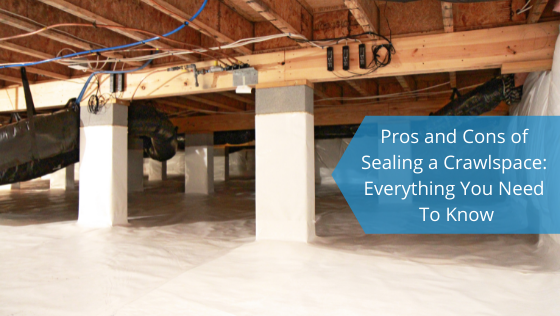If dirty, dark and damp are the words you think about when you consider your crawlspace, it’s easy to ignore these locations in your home. Unfortunately, when you ignore your crawlspace, you can end up with a really dark situation, with summer’s heat or winter’s cold, moisture, humidity, pests, allergens, rot and mold. To make these areas more useful, dry and energy efficient, crawl space encapsulation takes care of a lot of these issues. However, is a sealed crawl space the right choice for your home and household? Is crawl space encapsulation worth the cost? Are there any negatives to crawl space encapsulation? Here are some crawl space encapsulation pros and cons you should consider before you decide.

Crawl Space Encapsulation Benefits
Keep More Pests Out of Your Home
Mice, spiders, termites, ants, flies: an unsealed crawl space lets you through the house and creates a highway for these creatures into your home, with the type changing depending on the season. By encapsulating your crawl space, unwanted insects and other pests can’t enter anymore. Though you’ll still need to take care of any pests that are already within your walls, no additional pests can enter after encapsulation. Your contractor can even find the perfect pest-specific barrier if you’re concerned about specific types of pests.
Reduced Crawl Space Moisture
Every home has humidity and moisture issues, but homes with crawl spaces magnify this issue, because of their tendency to trap moisture. This makes mold, mildew and fungus a problem, creating serious health issues, especially for those with allergies or asthma. If you’ve used mold removal services in the past, crawl space encapsulation can solve the problem, but you’ll need to clean and prepare the space first. Your sealed crawl space also protects your foundation, where moisture can lead to rot that affects your home’s structural integrity.
Improved Energy Efficiency
Unsealed crawl spaces are a serious leak for hot and cold air, as your HVAC system has to work hard to keep up with your family’s needs. Fortunately, when you encapsulate your crawl space, your HVAC system will no longer leak air to the outdoors, making it much more efficient. The conditioned crawl space helps to reduce your overall heating and cooling costs over the lifetime of your home, helping you recover the cost of encapsulation.
Additional Storage Space
When you encapsulate your crawl space, you’re creating a great space under your home that is dry, airtight and clean. If you can easily access this area, say by adding a well-insulated, airtight door, you’ll be able to treat your previously damp, dirty, dark crawl space like any other storage space you can find in your home, perfect for off-season storage of holiday decor and clothing.
Other Crawl Space Encapsulation Factors
Cost of Work
One of the biggest concerns for homeowners is the cost to seal crawl space areas. Generally speaking, it will run between $1,500 to $15,000 to encapsulate your crawl space, depending on the size, supplies used, crawl space condition and the labor that’s needed. However, you may see some additional costs beyond the encapsulation, such as adding insulation, or talking to a plumber or electrician to deal safely with any wires or pipes in the crawl space. That being said, the cost will be recovered with better health and lower energy bills.
Additional Maintenance
Your crawl space needs to be maintained whether it’s encapsulated or not, but it’s easier to ignore if you consider it a dirty, dark, damp place. An encapsulated crawl space needs to be inspected annually as a part of your home’s maintenance calendar. However, it’s a pretty easy process, you’re just going to make sure that the area stays well insulated and maintained. A few minutes to an hour with a flashlight ensures it will remain in good condition for many years to come.
Possible HVAC Upgrade
HVAC systems are selected for your home’s needs, so when your crawlspace is sealed, your home won’t have the same amount of air circulation. If you’ve got a combustion-based furnace, it may be hard for it to get enough oxygen to burn properly, making it less efficient. If your home doesn’t feel as warm as it used to following a crawl space encapsulation, consider an HVAC upgrade. On the bright side, this will almost certainly allow you to purchase a more efficient unit, improving your energy bills dramatically.
Potential Loss of Storage
If you didn’t already have or add a door to your crawl space prior to encapsulation, you may be losing some storage space. If you continue trying to store items in your crawlspace, breaking the seal to access them, you’ll be negating the benefits of the crawl space encapsulation. This is one reason why you may want to add an accessway prior to encapsulation, so that you don’t lose that storage space.
Next Steps for Crawl Space Encapsulation
If you’re wondering how to seal a crawl space, you’re not alone, but the issues faced with moisture, energy efficiency, pests and similar issues means that you’ll want to have the process handled professionally. If you have a basement, you may be wondering whether basement encapsulation is possible. Moisture Loc can help. Contact us today.

